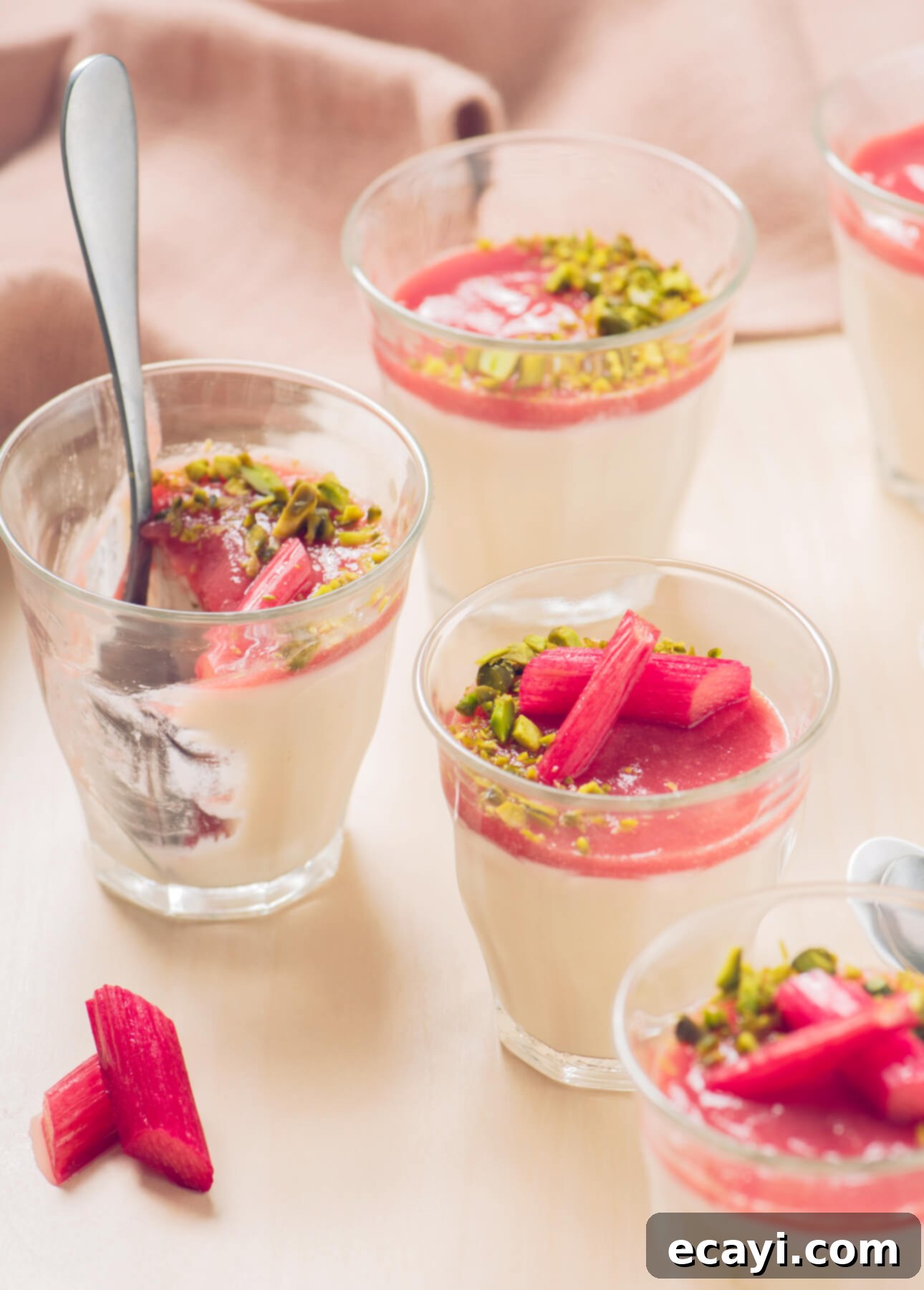Creamy Rhubarb Panna Cotta: A Delightful Spring Dessert Recipe
This Rhubarb Panna Cotta is an exceptionally easy and dreamily creamy dessert, specifically crafted to showcase rhubarb’s distinct sharp and bright taste in three different, yet harmonious ways. It’s a perfect treat for spring, offering a sophisticated balance of sweet and tart that will impress any palate.
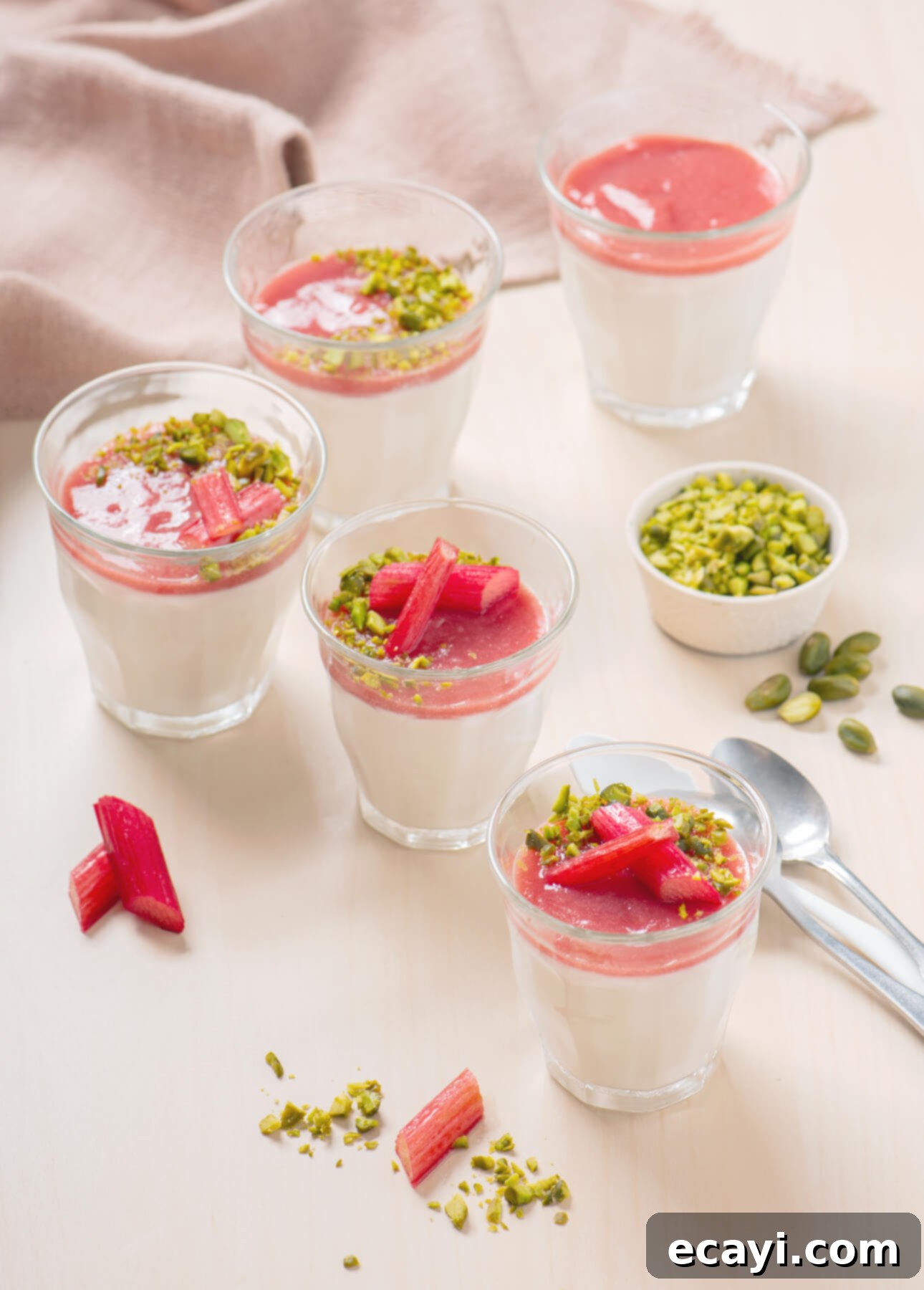
This post contains affiliate links. Full disclosure is at the bottom of the article.
Embracing the Rhubarb Season: A Culinary Journey
Spring truly comes alive with the vibrant arrival of fresh rhubarb. For many, it evokes nostalgic memories of childhood kitchens and comforting desserts. Growing up, my mother’s rhubarb cobblers and strawberry-rhubarb crisps were cherished annual traditions, marking the precious few weeks when these vibrant fruits perfectly overlapped in season. While I deeply cherish those homemade classics and often return to my parents’ home for a taste of her incomparable versions, I’ve also cultivated a new repertoire of rhubarb-centric favorites in my own kitchen.
Beyond the beloved cobblers and crisps, rhubarb’s unique tartness lends itself beautifully to an array of sophisticated treats. I regularly prepare timeless recipes like fruit compotes, bake delectable quick breads, and craft rustic pies. But my exploration of rhubarb extends further to more refined desserts such as luscious rhubarb gelato, delicate pâtes de fruits, and exquisite macarons. What captivates me most about rhubarb is its vibrant tang, a characteristic that perfectly offsets sweeter components, creating desserts that are refreshingly complex and never overly sugary. Much like citrus fruits, rhubarb has an incredible ability to infuse desserts with depth and a delightful zing that keeps you coming back for more.
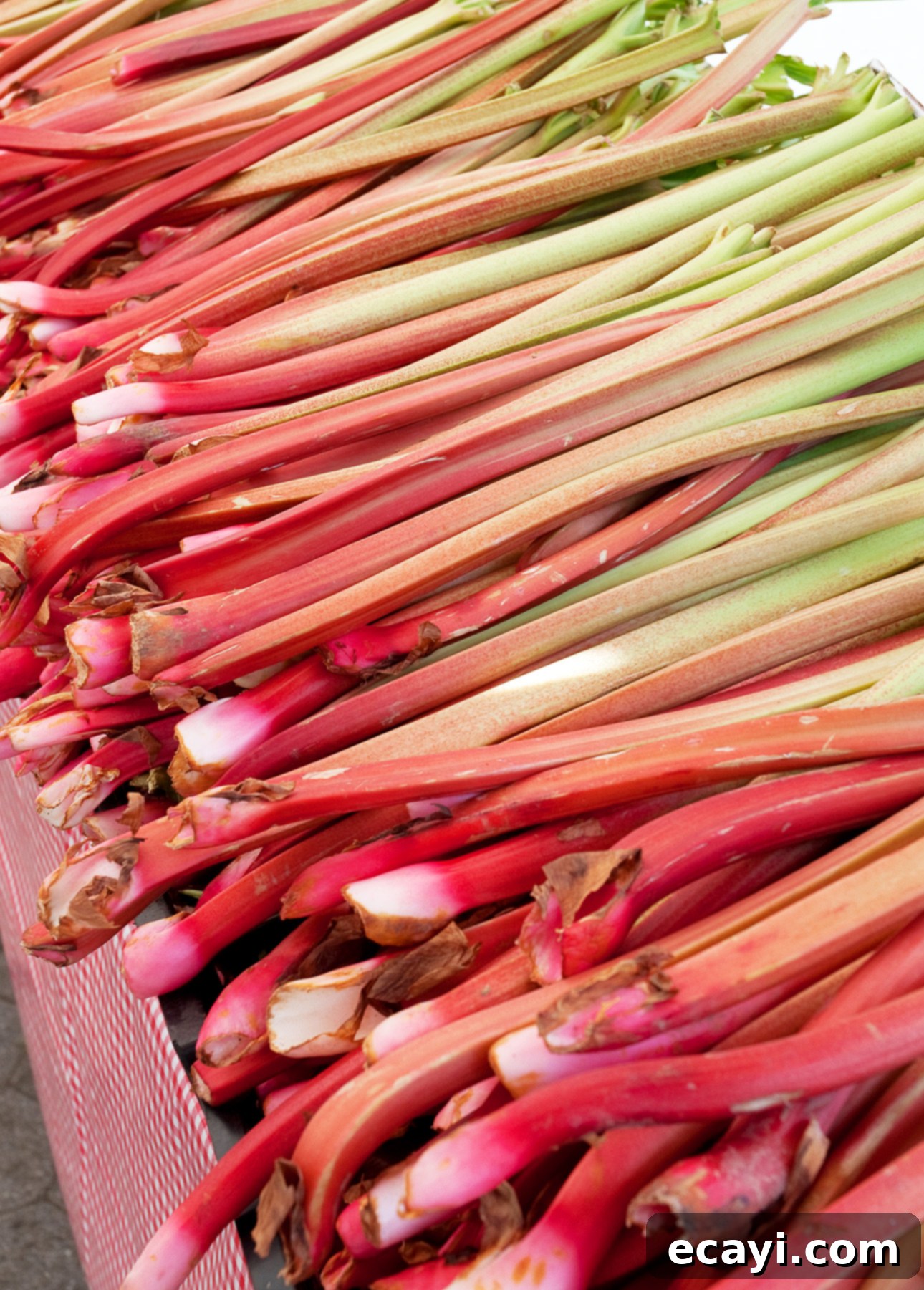
The Inspiration: A Dreamy Rhubarb Panna Cotta
This year, an irresistible idea took hold: to create an elegant rhubarb panna cotta. The vision was clear – to combine the silky, rich texture of classic panna cotta with the bright, assertive flavor of fresh rhubarb, resulting in a truly dreamy and unforgettable dessert. Luckily, I had a stash of last year’s rhubarb carefully tucked away in the freezer, allowing me to dive straight into experimenting and perfecting this memorable recipe. The balance of creamy indulgence and tangy fruit proved to be even more spectacular than I had imagined, leading to a dessert that is both simple to make and incredibly impressive to serve at any gathering or for a special weeknight treat.
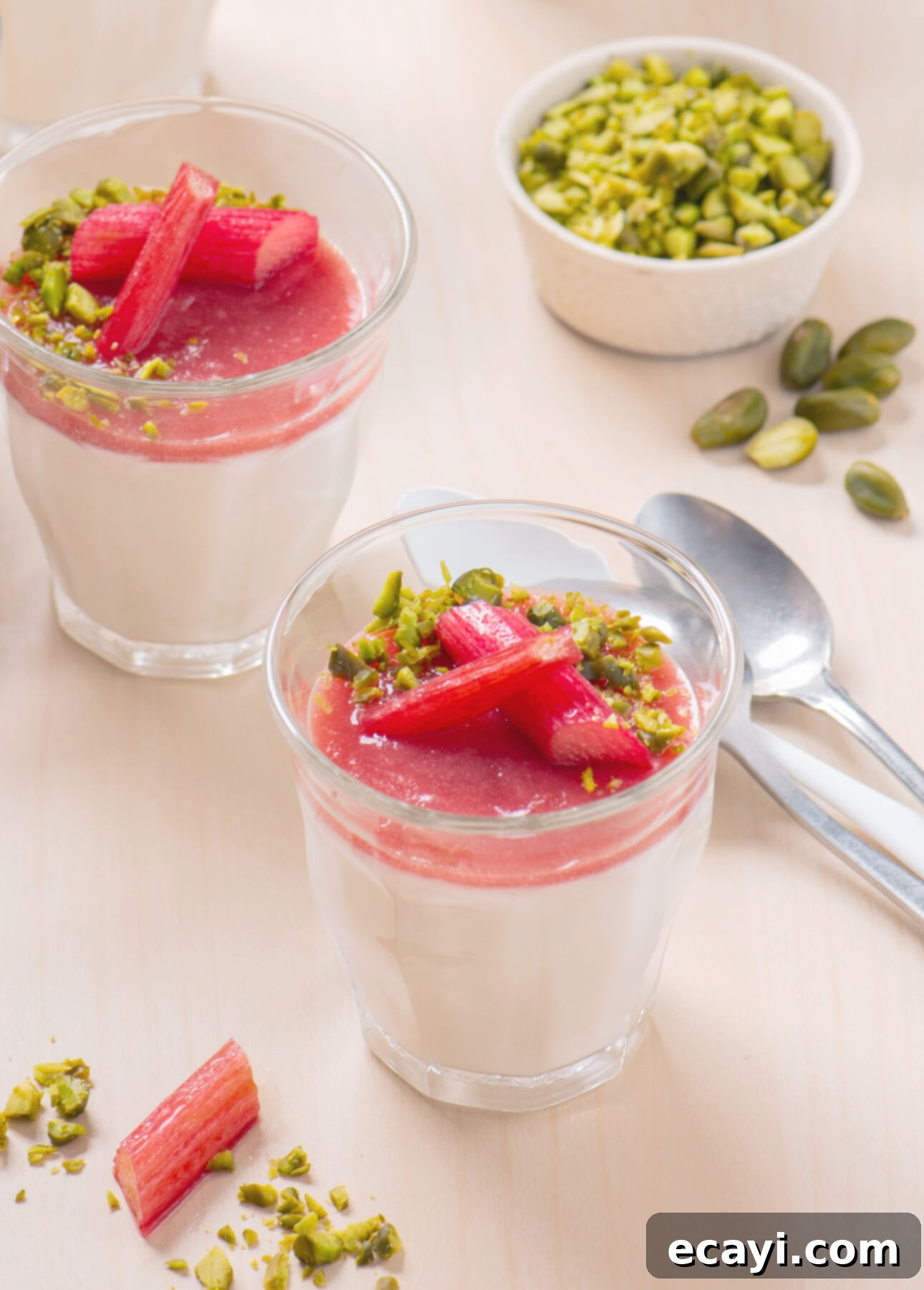
Showcasing Rhubarb in Three Exquisite Ways
This Rhubarb Panna Cotta recipe is a testament to the versatility of rhubarb, presenting its vibrant flavor in three distinct, yet complementary forms. Each element plays a crucial role in creating a layered and truly delightful dessert:
- Rhubarb Compote Infused Panna Cotta: A generous portion of homemade rhubarb compote is gently folded into the panna cotta base. This infusion introduces a subtle, zesty note and a beautiful pale pink hue to the creamy mixture, ensuring that rhubarb’s delightful essence is present in every single spoonful. It’s not just a topping, but an integral part of the panna cotta’s core flavor and texture, offering a harmonious blend from within.
- Rhubarb Compote Topping: The remaining, brighter rhubarb compote is reserved to generously spoon over the set panna cotta just before serving. This layer provides a concentrated burst of tangy rhubarb flavor and a striking pop of color, making the dessert both visually appealing and intensely flavorful. Its slightly thicker texture contrasts wonderfully with the smooth, yielding panna cotta beneath, adding another dimension of enjoyment.
- Delicate Poached Rhubarb Pieces: Thin stalks of rhubarb are gently poached in a vanilla-infused syrup until just tender, yet still holding their elegant shape. These delicate, slightly translucent pieces add an element of sophisticated texture and a milder, sweeter rhubarb note. They culminate in a spectacular presentation that elevates this simple dessert to an art form, providing a lovely textural counterpoint to the creamy base and vibrant compote.
Don’t hesitate to prepare extra batches of both the rhubarb compote and poached rhubarb! These versatile preparations are absolutely delicious on their own. Imagine them brightening your morning toast, swirling through creamy oatmeal, topping Greek yogurt, accompanying pancakes, or even enhancing a scoop of vanilla ice cream. They are culinary gems that you’ll undoubtedly find many uses for beyond this panna cotta.
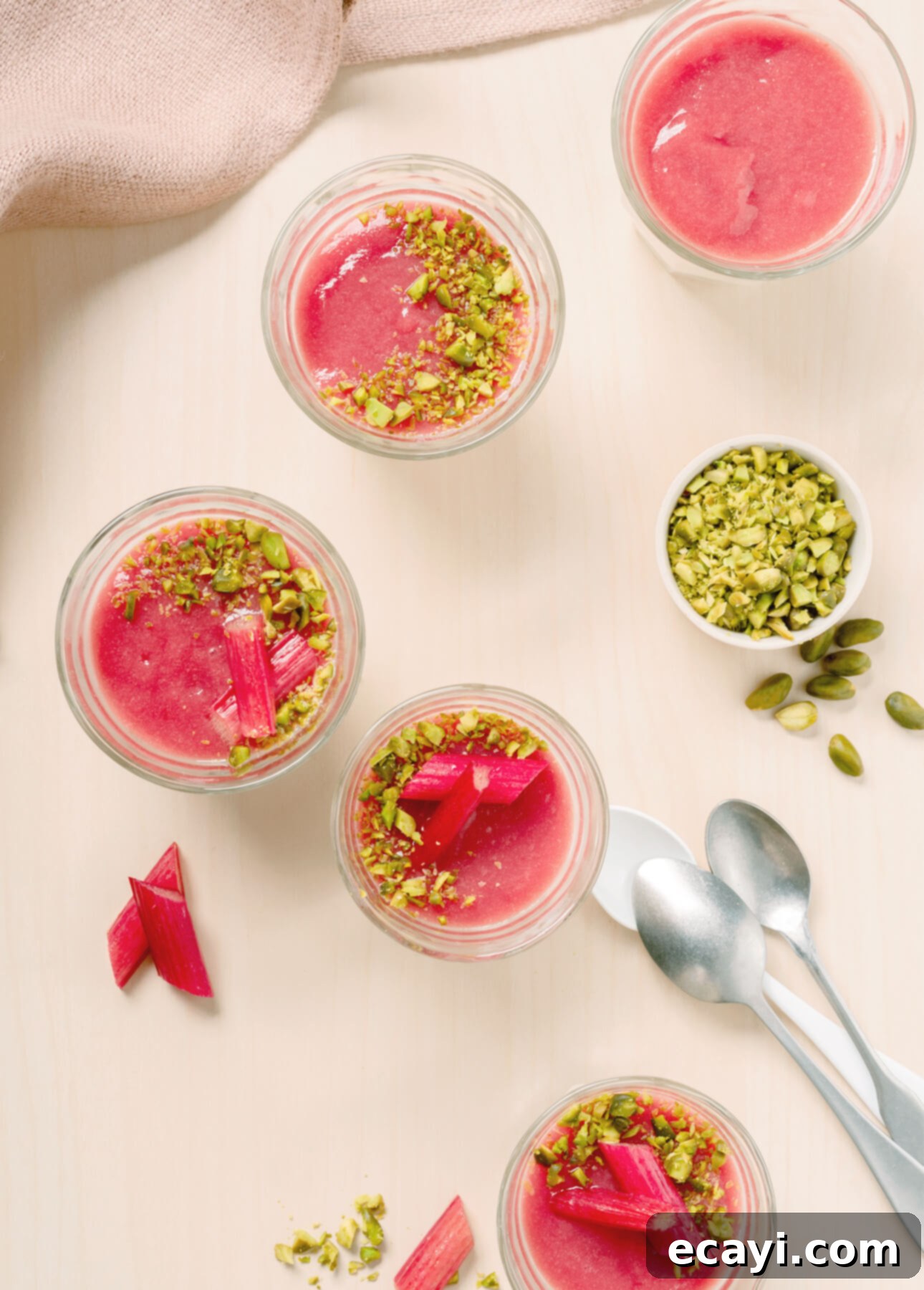
Essential Tips for Crafting Perfect Rhubarb Panna Cotta
Can I use frozen rhubarb for this panna cotta recipe?
Absolutely, yes! Both fresh and frozen rhubarb work wonderfully and interchangeably in this panna cotta recipe. The freezing process doesn’t compromise rhubarb’s characteristic tart flavor or its ability to break down into a delicious compote when cooked. If you’re using frozen rhubarb, there’s no need for a lengthy thawing process beforehand; simply add the frozen pieces directly to the saucepan as directed in the recipe instructions. This fantastic flexibility makes it possible to enjoy this delightful dessert long after rhubarb season has ended, ensuring a taste of spring can be savored all year round.
How to Stock Up on and Freeze Fresh Rhubarb for Year-Round Enjoyment
While enjoying fresh, in-season rhubarb is a true spring delight, a little foresight allows you to extend that joy throughout the year. Freezing fresh rhubarb is incredibly simple and ensures you’ll always have some on hand for desserts like this panna cotta, vibrant crisps, or comforting pies. Here’s a detailed guide on how to properly freeze rhubarb to preserve its quality:
- Select and Prepare: Start by choosing several vibrant, firm bunches of fresh rhubarb from your local market. Look for stalks that are crisp and free of any soft spots or blemishes. Crucially, trim off all the leaves, as they contain oxalic acid and are toxic; discard them responsibly. Then, wash the stalks thoroughly under cold running water to remove any dirt or debris.
- Cut to Size: Cut the clean rhubarb stalks into manageable 5-inch (12.5 cm) lengths. This size is convenient for most recipes and for efficient storage within your freezer. For smaller recipes or quicker thawing, you can also chop them into smaller 1-inch pieces.
- Package for Freezing: Once cut, you have a couple of options for packaging. The simplest method is to pack the cut rhubarb pieces directly into resealable freezer bags. Try to remove as much air as possible from the bags before sealing to prevent freezer burn, which can diminish flavor and texture. For an even better result, especially if you want to prevent the pieces from clumping together, you can flash freeze them first. To do this, spread the cut rhubarb in a single layer on a baking sheet lined with parchment paper. Freeze for 1-2 hours until solid, then transfer the frozen pieces to resealable freezer bags.
- Storage Time: Properly frozen rhubarb will maintain its peak quality for up to 3 months in a standard refrigerator freezer. For longer storage, up to 1 year, a dedicated chest freezer or deep freeze is ideal, as it maintains a more consistent, colder temperature.
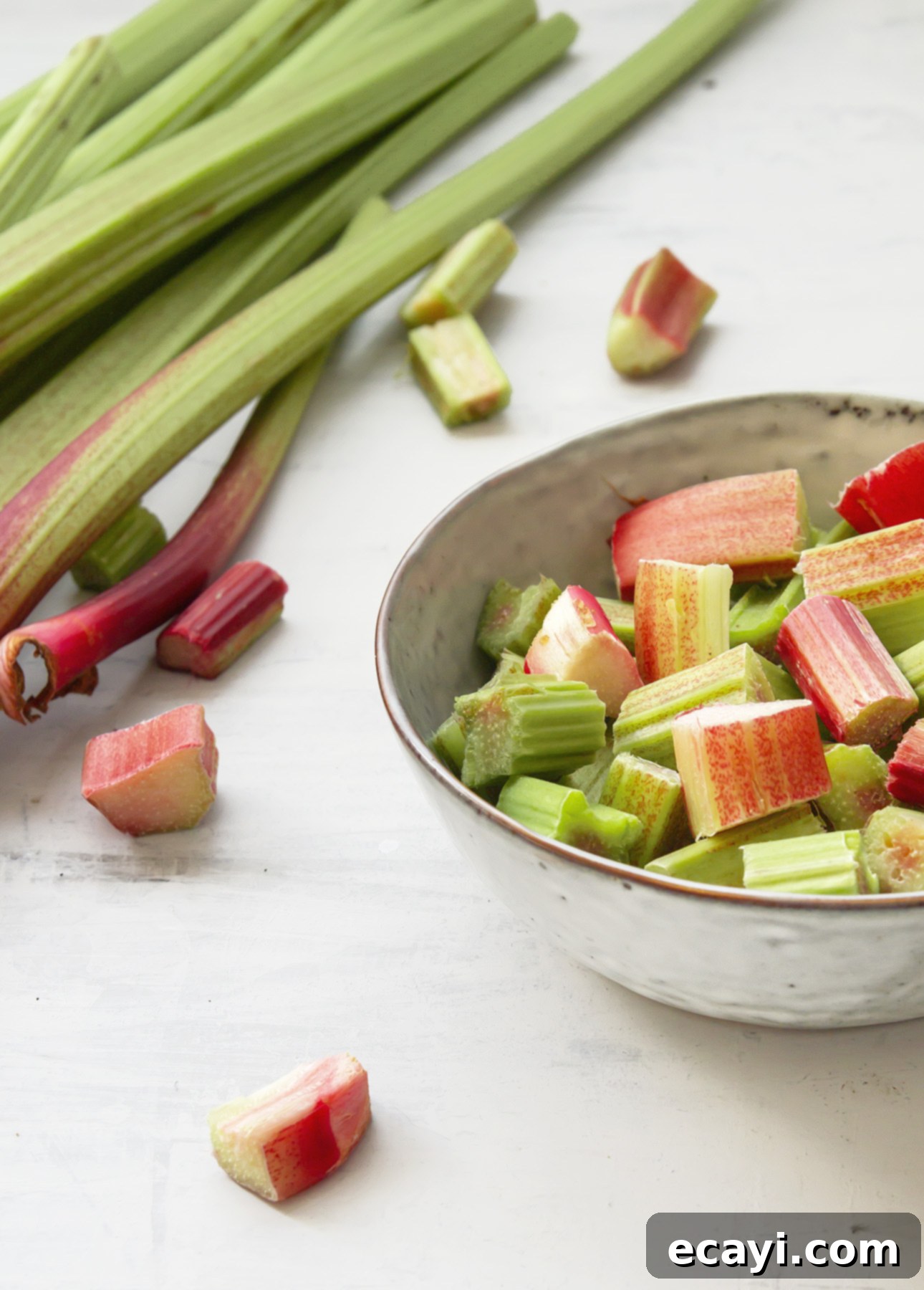
Can I make Rhubarb Panna Cotta in advance?
Yes, absolutely, and in fact, making panna cotta in advance is highly recommended for optimal results! Panna cotta, which literally means “cooked cream” in Italian, requires several hours in the refrigerator to properly set into its characteristic silky, wobbly texture. For optimal results and stress-free entertaining, it’s best to prepare it at least a half-day ahead of when you plan to serve it, or even the day before. Once set, rhubarb panna cotta can be safely refrigerated for up to 5 days, making it an ideal make-ahead dessert for dinner parties or simply to enjoy throughout the week. Remember to always add your chosen garnishes, such as the rhubarb compote and poached pieces, just before you plan to serve to ensure they look as fresh and vibrant as possible.
Why does gelatin need to rest, or “bloom,” before I use it?
The “blooming” of gelatin is a simple yet profoundly crucial step for achieving a flawlessly smooth and creamy panna cotta texture. Powdered gelatin, as it’s typically sold, is a dry, granular substance that requires proper rehydration before it can effectively thicken liquids. This essential process is what we refer to as “blooming.”
When you gently sprinkle gelatin over a cool liquid (like the specified portion of milk in this recipe) and allow it to rest undisturbed, the tiny granules of gelatin begin to absorb the liquid and swell. This transformation results in a soft, translucent, gel-like mass. This pre-hydration step ensures that when the hot liquid is subsequently added, the gelatin dissolves completely and evenly into the mixture. This uniform dissolution is key to preventing any undesirable gritty texture or undissolved lumps in your final dessert. If gelatin isn’t bloomed properly, it can lead to a less stable panna cotta, one with an inconsistent mouthfeel, or even visible undissolved particles. So, while “blooming” might sound like a technical culinary term, it’s an incredibly easy and essential step that guarantees a professional and delicious outcome: simply sprinkle, wait patiently, and let the gelatin work its hydrating magic!
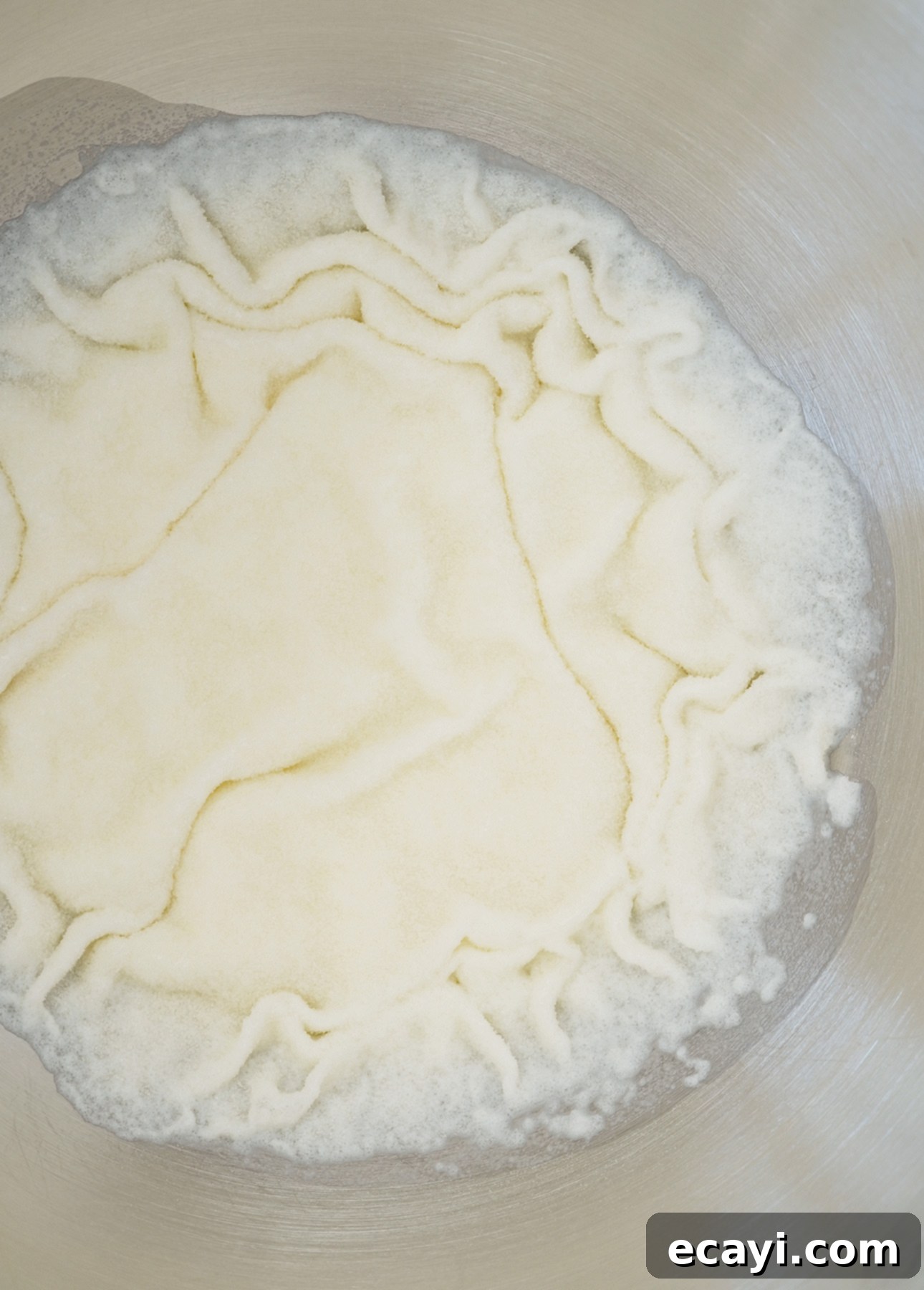
Can I use gelatin sheets instead of powdered gelatin?
Yes, you can absolutely substitute gelatin sheets for powdered gelatin in this rhubarb panna cotta recipe. Powdered gelatin, such as Knox unflavored gelatin, is widely available in North American supermarkets. However, in many parts of Europe and elsewhere, gelatin sheets are often easier to find and favored by many chefs for their clear, smooth set.
To make the substitution effectively:
- Conversion Ratio: For every 1 packet of powdered gelatin (which typically equals 2 1/2 teaspoons), substitute 5 sheets of gelatin. The sheets I typically refer to measure approximately 2-7/8″ x 8-1/2″ (7 cm x 11.5 cm). It’s worth noting that gelatin sheets come in different “bloom” strengths (e.g., gold, silver, bronze), but this ratio generally works well for standard common sheets.
- Rehydration Process: To rehydrate gelatin sheets, simply place them in a bowl of cold water and let them steep for about 5 minutes until they become soft, pliable, and translucent.
- Method Adjustment: When using gelatin sheets, you can streamline the process slightly. You can warm up all the milk and cream together in the saucepan, without needing to reserve 1/2 cup (125 ml) of milk for blooming.
- Dissolving Gelatin Sheets: Once the gelatin sheets are soft, carefully drain them from the cold water and gently squeeze out any excess moisture. Add these softened sheets directly to the hot milk and cream mixture in the saucepan, stirring continuously until they are fully dissolved. Proceed with the rest of the panna cotta recipe as instructed from that point forward.
How to make vegan panna cotta
Creating a delicious and delightful vegan rhubarb panna cotta is quite straightforward with a few simple, yet effective substitutions:
- Plant-Based Milk and Cream: Replace traditional dairy milk and heavy cream with plant-based alternatives. For the best results in terms of smooth texture and neutral flavor that allows the rhubarb to shine, I highly recommend a combination of oat milk and soy cream. Both offer a beautifully creamy consistency. Alternatively, full-fat coconut cream can also be used for a richer, slightly more tropical undertone, but be mindful of the coconut flavor subtly influencing the rhubarb.
- Agar Agar as a Thickener: Instead of gelatin, which is animal-derived, use agar agar powder. Agar agar is a powerful plant-based gelling agent derived from seaweed. Substitute 1 teaspoon (5 ml) of agar agar powder for the specified gelatin amount. Keep in mind that agar has a stronger setting power than gelatin, and it sets more firmly, so a precise measurement is important, and a little goes a long way.
- Adjusted Method: When working with agar agar, you can skip the gelatin blooming step entirely. Instead, whisk all the panna cotta ingredients, including the agar agar powder, together directly in a saucepan. Bring the mixture to a gentle simmer, whisking continuously for 2-3 minutes. This simmering ensures the agar agar fully dissolves and activates its gelling properties. Once simmered, divide the mixture into your serving glasses or molds and refrigerate as indicated until thoroughly set.
How to make dairy-free panna cotta
To make this exquisite rhubarb panna cotta dairy-free while retaining its creamy texture and vibrant flavor, simply substitute the regular milk and heavy cream with plant-based alternatives. My preferred choices for their smooth consistency and subtle, neutral flavor are a combination of oat milk and soy cream. These allow the bright, tart flavor of the rhubarb to remain the undisputed star of the show. If you enjoy a slight hint of tropical flavor, full-fat coconut cream is another excellent dairy-free option that provides a wonderfully rich and creamy texture.
Creative Ways to Serve Rhubarb Panna Cotta
While serving panna cotta in elegant small glasses, as beautifully pictured, is always a delightful choice, you have several options to present this exquisite dessert, each offering a unique aesthetic:
- In Individual Glasses or Bowls: This is perhaps the easiest and most common way to serve panna cotta. Simply pour the prepared mixture directly into attractive glasses, dessert bowls, or even small Mason jars. Once chilled and set, top generously with the rhubarb compote and poached rhubarb pieces just before serving. This method minimizes effort, ensures perfect individual portions, and allows for a stunning layered presentation.
- Unmolded for a Classic Presentation: For a more traditional, refined, and truly show-stopping look, you can unmold your rhubarb panna cotta onto individual serving plates. The signature “wobbly” texture of panna cotta truly shines when presented this way. To achieve this elegant presentation, use ramekins or V-shaped smooth-sided glasses. Before pouring in the panna cotta mixture, very lightly coat the inside of each container with a neutral-flavored oil (such such as sunflower, canola, or vegetable oil) to aid in release. When ready to serve, run a thin, sharp knife carefully around the entire edge of the set panna cotta to loosen it. Then, invert the container gracefully over a chilled serving plate and give it a gentle shake. The panna cotta should gracefully slip right out. Arrange the reserved rhubarb compote and delicate poached rhubarb pieces artfully alongside or on top of the unmolded panna cotta for a truly professional finish.
- Garnish Creatively: Beyond the provided rhubarb toppings, consider adding a sprinkle of crushed shelled pistachios for a beautiful vibrant green contrast and a satisfying textural crunch. A few fresh mint leaves or a delicate edible flower can also elevate the visual appeal and add a hint of freshness. For an extra touch of sweetness or a different flavor profile, a light drizzle of high-quality maple syrup or a sprinkle of toasted coconut flakes could be lovely, especially with dairy-free versions.
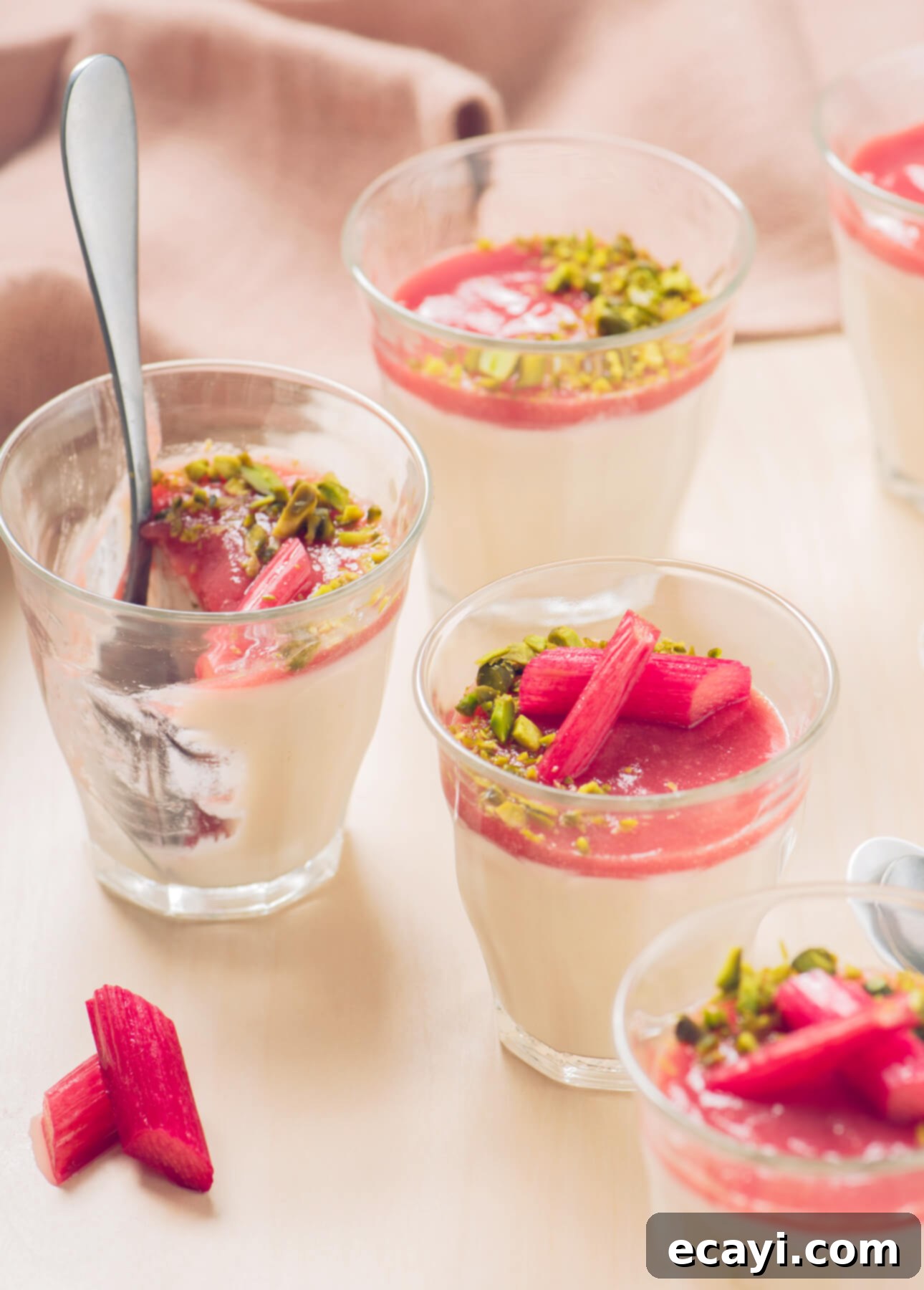
Explore More Panna Cotta Recipes
If you’ve enjoyed crafting and savoring this delightful Rhubarb Panna Cotta, you might also love exploring other exquisite variations of this wonderfully simple yet elegant Italian dessert. Each recipe offers a unique flavor profile to tantalize your taste buds:
- Maple Panna Cotta: A comforting and subtly sweet panna cotta that highlights the rich flavor of maple syrup.
- Maple & Orange Panna Cotta: A bright and aromatic twist, combining the warmth of maple with the zest of fresh oranges.
- Dairy-Free Almond Panna Cotta: A creamy, luscious option for those seeking a dairy-free treat, featuring the delicate nutty notes of almond.
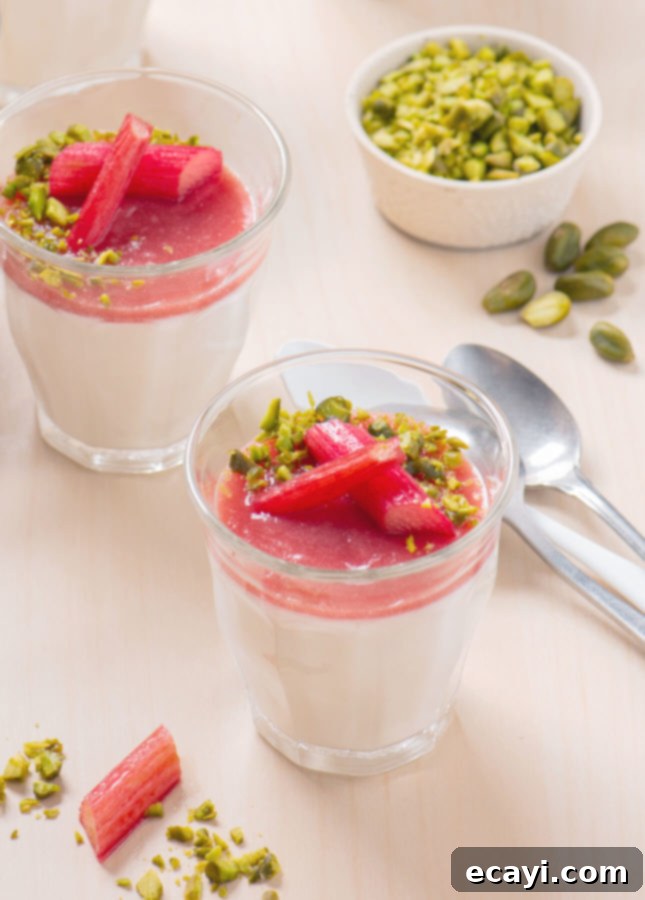
Pin Recipe
Rhubarb Panna Cotta
25 minutes
15 minutes
4 hours
8 servings
Marie Asselin
Ingredients
For the rhubarb compote
- 7 oz chopped rhubarb (about 1 ½ cups)
- ¼ cup elderflower honey, or any other type of honey
- Finely grated zest and juice from ½ lemon (about 2 tbsp/30 ml lemon juice and 1 tsp/5 ml zest)
- 1 tsp pure vanilla extract
For the rhubarb panna cotta
- 1 tbsp unflavored powdered gelatin (1 envelope)
- 1 cup whole milk (3.25% m.f.)
- 1 ½ cups heavy cream (35% m.f.)
- ½ cup homemade rhubarb compote
- 1 tsp pure vanilla extract
- ¼ cup elderflower honey or any other type of honey
For the poached rhubarb
- ½ cup granulated sugar
- ½ cup water
- 1 tsp pure vanilla extract
- 1 cup 2-in (5 cm) pieces of thin stalks of rhubarb
For serving
- Crushed shelled pistachios (optional)
Instructions
-
For the rhubarb compote: In a small saucepan, combine the chopped rhubarb, honey, lemon juice and zest, and vanilla extract. Set the saucepan over medium-high heat and bring the mixture to a boil. Once boiling, lower the heat to a simmer and cook, stirring from time to time, until the rhubarb pieces are very soft and easily break down, which typically takes about 10 minutes. Remove the compote from the heat. Blend it to a very smooth consistency using either a stick blender directly in the saucepan or carefully transfer it to a stand blender. You should end up with approximately 1 cup (250 ml) of rhubarb compote. Transfer 1/2 cup (125 ml) of this compote to an airtight jar and refrigerate for use as a topping later. Reserve the remaining compote for mixing into the panna cotta base.
-
For the rhubarb panna cotta: Begin by pouring 1/2 cup (125 ml) of the whole milk into a large, shallow bowl. Evenly sprinkle the unflavored powdered gelatin over the surface of the milk and let it rest undisturbed for 5 minutes. This crucial “blooming” step allows the gelatin granules to fully hydrate without clumping, ensuring a smooth final texture.
-
In a separate medium saucepan, combine the remaining 1/2 cup (125 ml) of whole milk and the 1 ½ cups of heavy cream. Whisk in the honey and vanilla extract until all ingredients are well combined. Heat this mixture over medium heat, stirring occasionally to prevent scorching, until it reaches a gentle simmer. It’s important not to let it boil vigorously. Once simmering, whisk in the reserved rhubarb compote (the portion that was not refrigerated for topping).
-
Carefully pour the very hot milk and cream mixture from the saucepan over the bloomed gelatin in the large bowl. Whisk continuously and thoroughly until the gelatin is completely dissolved and no granules or lumps remain. The mixture should be perfectly smooth and uniform. Divide the warm rhubarb panna cotta mixture evenly among 8 small serving glasses, bowls, or ramekins. Cover each with plastic wrap to prevent a skin from forming and refrigerate for at least 4 hours, or preferably overnight, to allow the panna cotta to set firmly and achieve its characteristic wobbly texture.
-
For the poached rhubarb: In a small saucepan, combine the water and granulated sugar. Bring this mixture to a gentle simmer over medium heat, stirring until the sugar is fully dissolved, creating a clear simple syrup. Stir in the pure vanilla extract for added aroma. Carefully add the 1 cup of 2-inch (5 cm) pieces of thin rhubarb stalks to the hot syrup. Simmer for approximately 5 minutes, or until the rhubarb pieces are just tender enough to be pierced with the tip of a knife but still retain their shape and a slight, pleasant bite. It’s crucial not to overcook them, as they can quickly turn mushy.
Place a fine-mesh strainer over a heatproof measuring cup or bowl and strain the poached rhubarb pieces, separating them from the syrup. Refrigerate the beautiful pink syrup for another use (it’s fantastic in smoothies, cocktails, or even sparkling water!). Allow the rhubarb pieces to cool completely, then transfer them to an airtight container and refrigerate until you are ready to serve the rhubarb panna cotta.
-
To serve: Once the panna cotta is fully set and thoroughly chilled, retrieve the refrigerated rhubarb compote (the topping portion) and the poached rhubarb pieces. Spoon about 1 tablespoon (15 ml) of the chilled rhubarb compote over the top of each panna cotta. Artfully arrange a few pieces of the delicate poached rhubarb on top of the compote for an elegant touch. For an extra pop of color, texture, and sophisticated flavor, sprinkle with crushed shelled pistachios, if desired. Serve immediately and savor this delightful, multi-layered rhubarb dessert that perfectly captures the essence of spring!
-
MAKE IT DAIRY-FREE: To prepare a dairy-free version of this exquisite dessert, simply swap out the conventional milk and heavy cream for your favorite plant-based alternatives. My personal preference for achieving a smooth texture and allowing the rhubarb’s bright flavor to dominate is a blend of oat milk and soy cream. However, full-fat coconut cream also works wonderfully, offering a rich, creamy consistency with a subtle hint of coconut that complements the rhubarb beautifully. Ensure all other ingredients, such as honey, are suitable for your dietary needs.
-
MAKE IT VEGAN:
Achieving a delectable vegan panna cotta is entirely possible by making these specific adjustments:
– Dairy Substitution: As with the dairy-free version, substitute regular milk and cream with plant-based options. Again, a mix of oat milk and soy cream is highly recommended for their smooth consistency and neutral taste, ensuring rhubarb remains the star. Coconut cream is another excellent alternative for a richer flavor profile.
– Gelatin Replacement: Replace the gelatin with 1 teaspoon (5 ml) of agar agar powder. Agar agar, derived from algae, is a powerful plant-based gelling agent, so a smaller quantity is needed compared to gelatin.
– Method Adjustment: When using agar agar, you can entirely skip the gelatin blooming step. Instead, combine all the panna cotta ingredients, including the agar agar, directly in a saucepan. Whisk thoroughly as you bring the mixture to a light simmer and maintain it for 2-3 minutes. This simmering is crucial as it ensures the agar agar fully dissolves and activates its gelling properties. Once simmered, divide the mixture among your serving glasses and refrigerate until perfectly set and chilled.
Did you make this?
Tell me how you liked it! Leave a comment or take a picture and tag it with @foodnouveau on Instagram.
This site participates in the Amazon Associates Program, an affiliate advertising program designed to provide a means for the site to earn fees by linking to Amazon and affiliated sites.
If you click on an affiliate link, I may earn advertising or referral fees if you make a purchase through such links at no extra cost to you. This helps me create new content for the blog–so thank you! Learn more about advertising on this site by reading my Disclosure Policy.
